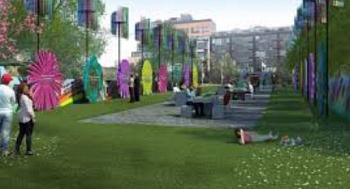North Brooklyn Locals Do Not Like the Plastic Mural Proposed For Their Park
Last year, East River State Park in Williamsburg was renamed for the late Black trans activist Marsha P. Johnson and became the first in state history to be named after an LGBTQ figure. Since then, the state unveiled a design to revamp the seven-acre waterfront space that has upset a lot of locals. What began as a celebratory milestone is now a battle over what makes a park, well, a park. Here’s the rundown.
Who’s fighting? North Brooklyn residents and community board members versus the New York State Office of Parks, Recreation and Historic Preservation
What do we know about the park? East River State Park is a perfectly acceptable spot to eat breakfast sandwiches and dog watch, but it has always been better suited to hosting the Smorgasburg food market and sweaty rock concerts than a grassy hang. It belongs to a small category of waterfront parks that feel like industrial remnants (it was built on the site of a former marine terminal, after all). But are its patches of grass and sand dear to locals? Without a doubt, yes.
What’s everyone mad about? As part of the park’s redesign, roughly an acre of concrete slab will be covered with a thermoplastic mural printed with rainbow stripes and planted with eight-foot-tall sculptural flowers as a tribute to Johnson, who often wore flowers in her hair. Locals are livid that the redesign doesn’t include a major expansion of green space or real flower beds. They also say that local residents never had a chance to offer meaningful feedback. Cristina Herrera, the founder and CEO of Trans Latina Network, who lives around the corner from the park, called it disappointing that the state’s first public space dedicated to a trans person didn’t include more feedback from queer locals.
Wait, do locals just want to preserve their park the way it is? Not really. Plans to transform the local park into an educational space have been in the works since 2018, but, unlike the mural design, were presented to the local community board several times and are moving forward without controversy.
The blow-by-blow: The new design was announced last August, but state officials waited until a few days before the park was set to close for construction in January to present it to Brooklyn Community Board 1. This only allowed a single meeting for locals to weigh in and learn about the park’s closure.




